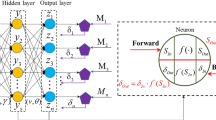Abstract
In this work, leather material is for the first time prepared by grit blasting process in order to improve peel strength when bonding. Peel tests show that it is the surface depth of removal rather than surface roughness that dominates the bonding performance. Therefore, measurement of surface removal is critical for surface preparation of using a grit blasting process. Indirect measurement of preparation performance is essential due to the hazardous conditions for conventional sensing equipment in the blasting chamber. A neural network modelling approach is proposed for the prediction of surface removal of leather materials, and the neural network model also characterizes the process, which is very useful for machine design and optimum control. The data used for the training of the artificial neural network is collected through screening experiments, which was efficiently planned using the Box-Behnken design method.
Similar content being viewed by others
References
Girosi F, Poggio T (1990) Networks and the best approximation property. Biol Cybern 63:169–179
Park J, Sandberg IW (1991) Universal approximation using radial basis function networks. Neural Comput 3:246–257
Zhang G, Patuwo BE, Hu MY (1998) Forecasting with artificial neural networks: The state of the art. Int J Forecast 14:35–62
Lou MS, Chen JC, Li CM (1998) Roughness prediction technique for CNC end-milling. J Ind Technol 15(1):2–6
Suresh PVS, Rao PV, Deshmukh SG (2002) A genetic algorithmic approach for optimization of surface roughness prediction model. Int J Mach Tools Manuf 42:675–680
Ho S-Y, Lee K-C, Chen S-S, Ho S-J (2002) Accurate modelling and prediction of surface roughness by computer vision in tuning operations using an adaptive neuro-fuzzy inference system. Int J Mach Tools Manuf 42:1441–1446
Sette S, Boullart L, Van Langenhove L (1996) Optimization a production process by a neural network/genetic algorithm approach. Artif Intell 9(6):681–689
Lee BY, Yu SF, Juan H (2004) The model of surface roughness inspection by vision system in tuning. Mechtronics 14:129–141
Benardos PG, Vosniakos GC (2002) Prediction of surface roughness in CNC face milling using neural networks and Taguchi’s design of experiments. Robot Comput Integr Manuf pp 343–354
Montgomery DC (2001) Design and analysis of experiments, 5th edn. Wiley, New York
Nagarajan G, Natarajan K (1998) The use of Box-Behnken design of experiments to study in vitro salt tolerance by Pisolithus tinctorius. World J Microbiol Biotechnol 15(2): 197–203
Baldock P, Mills V, Stewart PS (1996) A comparison of microbatch and vapour diffusion for initial screening of crystallization conditions. J Crystal Growth 168:170–174
Box GEP, Hunter WG, Hunter JS (1978) Statistics for experimenters. Wiley, New York
Del Cano T, Sansano A, Rodriguez-Perez MA, Gonzalez A, deSaja JA (2004) Implement of a CCD spectrometer as experimental set-up to evaluate the emission of an electroluminescent device using the Taguchi methodology. Measurement 35(3):257–268
Ramasawmy H, Blunt L (2002) 3D surface characterisation of electropolished EDMed surface and quantative assessment of process variables using Taguchi Methodology. Int J Mach Tools Manuf 42(10):1129–1133
Kalkkuhl J, Hunt KJ (1999) FEM-based neural-network approach to nonlinear modeling with application to longitudinal vehicle dynamics control. IEEE Trans Neural Networks. 10(4):885–897
Rivals I, Personnaz L (2003) Neural-network construction and selection in nonlinear modeling. IEEE Trans Neural Networks 14(4):804–809
Zhang J, Morris AJ (1999) Recurrent neuro-fuzzy networks for nonlinear process modeling. IEEE Trans Neural Networks 10(2):313–326
Scarselli F, Tsoi AC (1998) Universal approximation using feedforward neural networks: A survey of some existing methods, and some new results. Neural Networks 11(1):15–37
Billings SA, Jamaluddin HB, Chen S (1992) Properties of neural networks with applications to modelling nonlinear dynamical systems. Int J Control 51:1191–1214
Masters T, Land W (1997) A new training algorithm for the general regression neural network. IEEE Int Conf Systems, Man, Cybernetics Computational Cybernetics Simulation 3:1990–1994
Hagan MT, Menhaj MB (1994) Training feedforward networks with the Marquardt algorithm. IEEE Trans Neural Networks 5(6):989–993
Author information
Authors and Affiliations
Corresponding author
Rights and permissions
About this article
Cite this article
Hu, Z., Bicker, R. & Marshall, C. Prediction of depth removal in leather surface grit blasting using neural networks and Box-Behnken design of experiments. Int J Adv Manuf Technol 32, 732–738 (2007). https://doi.org/10.1007/s00170-005-0381-6
Received:
Accepted:
Published:
Issue Date:
DOI: https://doi.org/10.1007/s00170-005-0381-6




